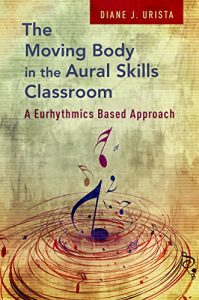Inspired by Dalcroze-eurhythmics, this book is a practical guide for teachers and students interested in integrating the moving body into the aural skills classroom. Author Diane J. Urista focuses on movement-to-music as a tool for developing musical perception and the kinesthetic aspects of performance. As this book demonstrates, moving to music and watching others move cultivates an active, multi-sensory learning experience in which students learn by discovery and from each other.
The book features a wealth of exercises that teach rhythmic, melodic, harmonic and formal concepts, including improvisation and expressive exercises. These exercises not only develop the ear, but also awaken the muscular and nervous system, foster mind-body connections, strengthen the powers of concentration, develop inner-hearing, short- and long-term memory, multi-tasking skills, limb autonomy, and expressive freedom. Exercises are presented in a graded but flexible order allowing readers to select individual exercises in any sequence. Activities involve movement through space as well as movement in place for those teaching in small classrooms. The book can be used as a teacher's manual, a supplementary aural-skills textbook, or as a stand-alone reference in a course dedicated to eurhythmics. Many exercises also provide an effective aural/sensory tool in the music theory classroom to complement verbal explanations. The approach integrates easily into any traditional college or conservatory classroom and is compatible with fixed do, moveable do, and scale degrees. A companion website features undergraduate students performing select exercises.
Visit the companion website at www.oup.com/us/movingbodyauralskillsclassroom
The book features a wealth of exercises that teach rhythmic, melodic, harmonic and formal concepts, including improvisation and expressive exercises. These exercises not only develop the ear, but also awaken the muscular and nervous system, foster mind-body connections, strengthen the powers of concentration, develop inner-hearing, short- and long-term memory, multi-tasking skills, limb autonomy, and expressive freedom. Exercises are presented in a graded but flexible order allowing readers to select individual exercises in any sequence. Activities involve movement through space as well as movement in place for those teaching in small classrooms. The book can be used as a teacher's manual, a supplementary aural-skills textbook, or as a stand-alone reference in a course dedicated to eurhythmics. Many exercises also provide an effective aural/sensory tool in the music theory classroom to complement verbal explanations. The approach integrates easily into any traditional college or conservatory classroom and is compatible with fixed do, moveable do, and scale degrees. A companion website features undergraduate students performing select exercises.
Visit the companion website at www.oup.com/us/movingbodyauralskillsclassroom






